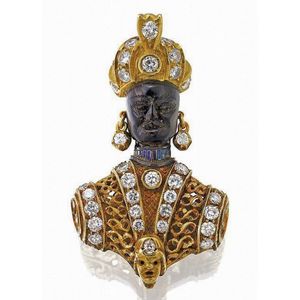Masriera Pendant: Gold, Ivory, Enamel, Diamonds & Sapphires
You must be a subscriber, and be logged in to view price and dealer details.
Subscribe Now to view actual auction price for this item
When you subscribe, you have the option of setting the currency in which to display prices to $Au, $US, $NZ or Stg.
- Important - Important is a word used in the antique trade to indicate an object should be ranked above other similar objects, and is therefore more valuable.
The object could be considered important because it is by a famous designer or maker, has been shown at a major exhibition, is of exquisite workmanship, is rare or is a "one-off", was made for an important patron, and so on.
Even further up the pecking order are objects that are described in catalogue descriptions as highly important or extraordinarily important. - Attributed - A cataloguing term where the item in the opinion of the cataloguers, is a of the period of the artist, craftsman or designer, and which probably in whole or part is the work of that person.
- Circa - A Latin term meaning 'about', often used in the antique trade to give an approximate date for the piece, usually considered to be five years on either side of the circa year. Thus, circa 1900 means the piece was made about 1900, probably between 1895 and 1905. The expression is sometimes abbreviated to c.1900.
- Ivory - Ivory is a hard white material that comes from the tusks of elephants, mammoth, walrus and boar, or from the teeth of hippopotamus and whales. The ivory from the African elephant is the most prized source of ivory. Although the mammoth is extinct, tusks are still being unearthed in Russia and offered for sale.
Ivory has been used since the earliest times as a material for sculpture of small items, both in Europe and the east, principally China and Japan.
In Asia ivory has been carved for netsuke, seals, okimono, card cases, fan supports, animals and other figures and even as carved tusks.
In the last 200 years in Europe ivory has been used to carve figures, for elaborate tankards, snuff boxes, cane handles, embroidery and sewing accessories, in jewellery and as inlay on furniture. Its more practical uses include being used for billiard balls, buttons, and a veneers on the top of piano keys.
The use and trade of elephant ivory have become controversial because they have contributed to Due to the decline in elephant populations because of the trade in ivory, the Asian elephant was placed on Appendix One of the Convention on International Trade in Endangered Species (CITES), in 1975, and in January 1990, the African elephant was similarly listed. Under Appendix One, international trade in Asian or African elephant ivory between member countries is forbidden. Unlike trade in elephant tusks, trade in mammoth tusks is legal.
Since the invention of plastics, there have been many attempts to create an artificial ivory - Plique-A-Jour - Plique a jour, which translates from the French as ?glimpse of daylight? is a method of enamelling in which the backing is removed or cut away so the light shines through, with a similar effect to a stained glass window. The enamel is held in place by border.
Although the technique of plique-a-jour has been known and in use since the 6th century, it became popular again in the late 19th century, in Russia and Scandinavia. Plique-a-jour was popular in the Art Nouveau period, especially for jewellery.
Because of the length of time required to produce an item, and the high failure rate, production was limited, and the technique is little used today.
This item has been included into following indexes:
Visually similar items

Pearl and diamond set brooch, Nardi, modelled as a blackamoor, wearing a brilliant-cut diamond set tunic, articulated earrings and a matching turban highlighted with a pearl top, mounted in 18ct gold, length approximately 45 mm, signed Nardi. Accompanied b

A Russian brass and blue enamel triptych travelling icon, width 15.5 cm

A Christening icon, silver and metal frame. Diameter 90 mm

Scent Vial holder. Gold gilt brass, French enamelled floral design, micro mosaic centre, hexagon flask shape, with original glass, height 6 cm
